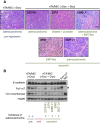Inducible and coupled expression of the polyomavirus middle T antigen and Cre recombinase in transgenic mice: an in vivo model for synthetic viability in mammary tumour progression
- PMID: 24457046
- PMCID: PMC3978996
- DOI: 10.1186/bcr3603
Inducible and coupled expression of the polyomavirus middle T antigen and Cre recombinase in transgenic mice: an in vivo model for synthetic viability in mammary tumour progression
Abstract
Introduction: Effective in vivo models of breast cancer are crucial for studying the development and progression of the disease in humans. We sought to engineer a novel mouse model of polyomavirus middle T antigen (PyV mT)-mediated mammary tumourigenesis in which inducible expression of this well-characterized viral oncoprotein is coupled to Cre recombinase (TetO-PyV mT-IRES-Cre recombinase or MIC).
Methods: MIC mice were crossed to the mouse mammary tumour virus (MMTV)-reverse tetracycline transactivator (rtTA) strain to generate cohorts of virgin females carrying one or both transgenes. Experimental (rtTA/MIC) and control (rtTA or MIC) animals were administered 2 mg/mL doxycycline beginning as early as eight weeks of age and monitored for mammary tumour formation, in parallel with un-induced controls of the same genotypes.
Results: Of the rtTA/MIC virgin females studied, 90% developed mammary tumour with complete penetrance to all glands in response to doxycycline and a T50 of seven days post-induction, while induced or un-induced controls remained tumour-free after one year of induction. Histological analyses of rtTA/MIC mammary glands and tumour revealed that lesions followed the canonical stepwise progression of PyV mT tumourigenesis, from hyperplasia to mammary intraepithelial neoplasia/adenoma, carcinoma, and invasive carcinoma that metastasizes to the lung; at each of these stages expression of PyV mT and Cre recombinase transgenes was confirmed. Withdrawal of doxycycline from rtTA/MIC mice with end-stage mammary tumours led to rapid regression, yet animals eventually developed PyV mT-expressing and -non-expressing recurrent masses with varied tumour histopathologies.
Conclusions: We have successfully created a temporally regulated mouse model of PyV mT-mediated mammary tumourigenesis that can be used to study Cre recombinase-mediated genetic changes simultaneously. While maintaining all of the hallmark features of the well-established constitutive MMTV-PyV mT model, the utility of this strain derives from the linking of PyV mT and Cre recombinase transgenes; mammary epithelial cells are thereby forced to couple PyV mT expression with conditional ablation of a given gene. This transgenic mouse model will be an important research tool for identifying synthetic viable genetic events that enable PyV mT tumours to evolve in the absence of a key signaling pathway.
Figures






References
Publication types
MeSH terms
Substances
Grants and funding
LinkOut - more resources
Full Text Sources
Other Literature Sources
Molecular Biology Databases
Research Materials

